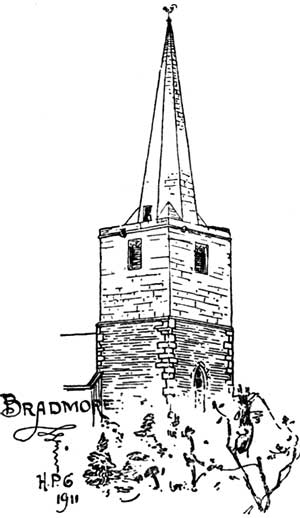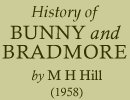Bunny and Bradmore
You cannot dip into the history of Bunny without mentioning Bradmore, for the Vicar of Bunny is also Vicar of Bradmore, although up to about 1770 they were separate parishes. The church was burnt down in 1705.
The name was formerly Broadmere, a broad lake. Like Bunny, it was carved out in the Ice Age: although on a rise, water lay on the west side of the settlement. The rising ground was chosen from the marshes and moor lands for building. The word moor comes in many limes in this old history—Moor Close, Moor Lane, Moor Watering. Other names of field are Labour in Vain, Frog Hole, Gorsey Close, then the first, second and third vineyards, reminders of the days when grapes were grown, and wine was male, and, I need not add, drank.
One historian says Bradmore was a considerable place before the Conquest.
Robert Malet was the first Norman owner of Bradmore, but he did not hold it for long.
Ralph Fitz Hubert, Lord of Bunny, owned it.
Thoroton suggest that Robert Malet and Fitz Hubert owned it together.
Hubert Fitz Ralph had an uncle, Richard, who adopted Bradmore as his surname. This nephew, just mentioned, bestowed Bradmore land on Richard, and his son passed them to the Rector of Bunny, and he gave them to Lenton Priory. This monastery also acquired tithes of land from Odo de Bunny, a great landowner in and about Keyworth.
Ralph de Freschville was descended from the Fitz Huberts, and he also gave a grant of land to the Priory. He said that Gervase de Somerville gave 100 acres to the Priory for the endowment of a hospital for those suffering from St. Anthony's fire, in other words St. Vitus' Dance.
Ralph de Freschville granted land to Bradmore with common pasture and the right to dig peat on land at Bunny.
In 1170 the fee of Fitz Ralph was divided between Henry de Stuteville and Hubert Fitz Ralph. Henry was lord of Kirkby in Ashfield.
The Stutevilles were a French family not always loyal to the English King. Richard Stuteville was out with the barons against Henry III. When peace was declared with the French in 1327 orders were given to Richard de Grey to restore the land at Bradmore, which Edward II seized when war broke out.
Richard de Grey had many properties in Notts, and he was anxious to possess Bradmore and Barton, and he bought them in 1332 from Stout, the son of Nicholas de Stuteville, for £800.
In 1335 a complaint was made about the Rector of Bunny mowing the hay and crops, and assaulting the monks.
Owing to mismanagement the Prior obtained a license to let its land at Bradmore on lease for five years, but this broke down.
Stout, son of Sir Nicholas de Stuteville, of Bradmore, sold lands to Richard de Grey. Quoting from Thoroton: "He passed the mannors of Barton and Bradmore to the said Richard de Grey of Codnor." These estates passed from Grey's to Willoughby's, probably by marriage.
According to Thoroton, "The Willughby's of Wollaton held the land until Queen Elizabeth's time, when it was sold to Richard Parkyns of Bunny."
In 1382 Roger Beler inherited the 8th of a knight's fee in Bradmore.
One historian says another owner was Ralph, Lord Cromwell. See Bunny history for this.
Returning to the Willoughbys, Sir Henry Willoughby went to Scotland in 1493, and left his estates in trust for his wife and son. The son, although a child, was engaged to be married to the daughter of Edward Grey, Viscount Lisle, and to hold him to this contract he pledged his manors of Willoughby and Bradmore. The two fathers were enemies.
About 1480 Edward Grey, Lord Lisle, came to Nottingham with an armed force and threatened Sir Henry, but afterwards they arranged this marriage to heal the breach. They were married in 1492 and the properties at Bradmore were restored.
Sir Henry Willoughby died in 1528, and his second son became heir, and the two families of Willoughbys and Greys were still reconciled. There were four inter-marriages, and Willoughby blood ran in the veins of Lady Jane Grey, the nine-day Queen of England, beheaded by Queen Mary; so Bradmore has a link with the royalty of our land.
In 1537 Bradmore was visited by a plague.
In 1635 Lenton Priory possessed land at Bradmore, which Queen Elizabeth granted to Roger Manners. It might possibly be the farm mentioned by Thoroton belonging to the Earl of Rutland, and acquired afterwards by the Parkyns.
All Bradmore was bought by Richard Parkyns.
Henry Stapleton, of Rempstone, had land at Bradmore. This man left a rent charge of £20 to his daughter Faith Babington and her heirs.
In 1586 4s. was paid to Longe of Bradmore for keeping a horse eleven days belonging to Gamaliel Quernby, and it was used in Babington's and Kingston's plot to murder Queen Elizabeth. We know the plot failed and Babington was beheaded.
The village of Bradmore, like Bunny, was well known for its rushes, which grew on the many marshes to the west of the settlement. They were used for seating chairs, thatching and strewing floors. The harvesting of these rushes was quite a local industry. Women used to carry bundles of rushes to Wollaton.
The Bradmore tenants carted lime, timber and bricks to Thurland Hall, Nottingham, for their landlord, Sir Francis Willoughby.
It was a revival of the old feudal system of England, when service was rendered in payment or part payment, of rent to the owner. Like Bunny tenants, they were rewarded with food and ale.
The inhabitants of Bradmore enjoyed themselves, we are told, but not always wisely, for we read in 1618 six men were summoned for profaning the Sabbath with "morrice" dancing.
The Bradmore Manor was bought by Sir Richard Parkyns in about 1596 from Sir Percival Willoughby. The manors of Bunny and Bradmore were taken from Colonel Isham Parkyns, but were restored in 1671.
He was created baronet for his loyalty.

The tower of Bradmore church.
The Church
The Parliamentary Commissioners reported 1650 "that there was a Chapelle in the saide towne of Bradmore belonging to the Parishe Church of Bunny, well situated and fit to be made a Parishe Church, but its minister, David Ghovan, preached very weakly and inefficiently." Thomas Rose, a Puritan, was ejected from Blidworth Vicarage He then preached at Bradmore, Wysall and West Bridgford, and for this he was imprisoned six months in Nottingham gaol. Following this, in 1699, Rose and William Cross were turned out of Beeston and Attenborough.
They then preached at Bradmore to a congregation of twenty at about the time of church service on Sundays in the house of Robert Kirkby, Bradmore, and they were taken before the justices for being absent from church. In July, 1705, much of the village of Bradmore was destroyed by fire, including the church, twelve dwelling houses, stables, tools, cheese, bacon, hay and peas, wool, and household stuff The total was said to be £6,000. Only the tower and spire of the church remain. It is a broach spire at Bradmore.
People were so sorry that briefs were allowed to be read in churches for the relief of the suffering, and collections were made. It was a sad time for Bradmore. Quoting: "The steeple stands without a church, and although dependent on Bunny, it has its own churchwardens." At that time it had 60 dwellings with a population of 300.
In 1881 a mission hall was built, adjoining the tower, where services were held.
By the efforts of the Bradmore people the steeple was restored in 19— at a cost of £100.
Bradmore has developed from a land of marsh and moor to the village on the highway with a nourishing chapel, and well built farmhouses.
The view from Blackcliffe Hill of the following five churches is well worth seeing, including Bradmore Steeple, Bunny, Keyworth, Plumtree and Ruddington.
The Ramper was said by one historian to be part of the old stockade, and Donkey Lane of the gypsies' time, where the animals grazed.
In 1811 the population of Bradmore was 407. The population of Bunny from 1801 to 1950 :
|
1801 |
1811 |
1821 |
1831 |
1841 |
Population - |
359 |
374 |
395 |
371 |
360 |
|
1851 |
1861 |
1871 |
1881 |
1891 |
Population - |
366 |
273 |
226 |
262 |
239 |
|
1901 |
1921 |
1954 |
|
|
Population - |
205 |
245 |
600 |
|
|
Acknowledgment.—My thanks are due to Mr. Holland Walker for the loan of his MSS., and to Mr. Robin Fraser for giving permission to use the photographs of the Church, also many thanks to the subscribers.
—M. H. HILL.
